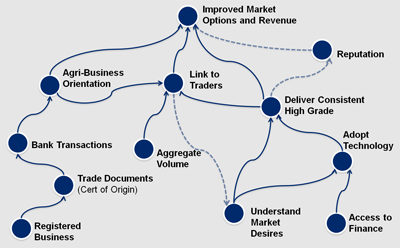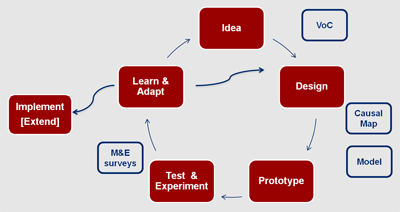Developing Rapid Solution Prototypes So That One “Fails Quickly” and “Fails Small"
This blog post was written by Nick Ramsing of MEDA who recently presented at Breakfast Seminar #67, Market Aggregation: Facilitating 'Game Changing' Opportunities in Ukraine.
Since its creation in 1953, Mennonite Economic Development Associates (MEDA) has been actively engaged in raising farmer productivity, crop yields, and linking smallholder farmers to markets. From initiating rural farmer cooperatives for bean production and marketing in Bolivia to facilitating horticulture value chains in Tajikistan and working alongside isolated women “through the garden gate” in Afghanistan, MEDA possesses deep experience in analyzing value chains, facilitating market actor linkages, and stimulating market opportunities for those previously outside formal markets. Leveraging MEDA’s capabilities and experience, the Ukrainian Horticulture Development Project (UHDP) seeks to develop and extend horticulture value chains (vegetables, table grapes, and strawberries) specifically targeting smallholder farmers in Crimea and Zaporozhye.
Currently operating in the fourth year of a five year, $12 million contract with Canadian International Development Agency (CIDA), UHDP focuses efforts on the following domains:
- Extension services: providing production support for horticulture crops and organizing trade fairs to raise awareness and stimulate collaboration within crop markets
- Innovative technologies: implementing improved greenhouses and cold storage through local suppliers and deploying weather stations with crop models to improve crop management
- Financial services: providing leasing services through Agro Capital Management for agricultural inputs
- Cooperative development: assisting market actors to form business entities that conduct transactions with the formal, upscale market
- Market aggregation: aggregating produce from individual farmers to central consolidation points in order to transact with traders selling to upscale markets.
Prior to focusing on these areas, the UHDP team spent time analyzing the horticulture market, leveraging value chain analysis and its own market research and program design toolkits. These toolkits, as well as the tailored methodology, are rooted in value chain best practices. Gathering information with and from market actors via focus groups, interviews, and other tools, MEDA began formulating an understanding of the market and its challenges.  Continually asking “why” and attempting to see the market through the experiences of the market actors (voice of the customer), MEDA iterated its initial understanding and assumptions of the market through value chain mapping and causal maps. Leveraging an understanding of additional market system influences, MEDA hypothesized the general market challenge—lack of market access—and began the process to test and prototype solutions.
Continually asking “why” and attempting to see the market through the experiences of the market actors (voice of the customer), MEDA iterated its initial understanding and assumptions of the market through value chain mapping and causal maps. Leveraging an understanding of additional market system influences, MEDA hypothesized the general market challenge—lack of market access—and began the process to test and prototype solutions.
In testing its hypothesis and understanding of the market challenge, MEDA engaged in “design thinking,” reflecting a way of thinking about problems and designing solutions. The iterative process (Idea > Design > Prototype > Test/Experiment > Learn/Adapt)  reflects a perspective aimed at learning (about, from, and with market actors) and developing rapid solution prototypes so that one “fails quickly” and “fails small” while learning about what the market desires. Once an idea and design solution is found to be effective, it is scaled through implementation with partners and market actors.
reflects a perspective aimed at learning (about, from, and with market actors) and developing rapid solution prototypes so that one “fails quickly” and “fails small” while learning about what the market desires. Once an idea and design solution is found to be effective, it is scaled through implementation with partners and market actors.
One solution area—market aggregation—enabled smallholder farmers to form informal alliances and build on existing trading relationships of lead farmers to reach new upscale markets. In some cases, these informal alliances grew into formal, viable business entities that took on marketing, packaging, and bank transaction activities, providing consolidation services to smallholder farmers. Through this approach, UHDP has reached over 5,500 direct farmers and facilitated aggregation of 3,100 tons of horticulture goods valued at $7.8 million in last year’s season (2011).
Design Thinking resources
- Kelley, Tom; “The Art of Innovation: Lessons in Creativity from IDEO, America's Leading Design Firm” (Doubleday)
- TED talk: Tim Brown on “Creativity and play”, 2008 Serious Play conference
- MIT World: Tim Brown on “Innovation Through Design Thinking,” March 16, 2006
- Govindarajan, Vljay and Trimble, Chris; “The Other Side of Innovation: Solving the Execution Challenge” (Harvard Business Review)
- Liedtka, Jeanne and Ogilvie, Tim; “Designing for Growth: A Design Thinking Toolkit for Managers” (Columbia Business School Publishing)


